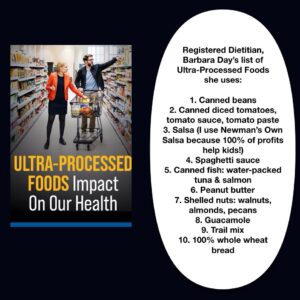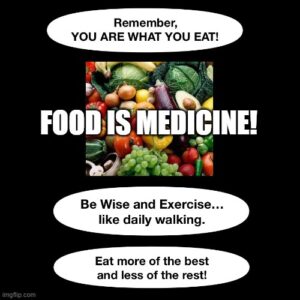Are Ultra-processed Foods Making You and Your Family Sick?

In today’s world, many Americans are eating more ultra-processed and processed foods and not eating real foods that contain adequate amounts of dietary fiber and other nutrients. 75% of Americans are overweight with 45% of children being labeled as overweight. 20% of kids are labeled as obese with about 1/3 of kids having diabetes or pre-diabetes around age 12.
According to research, 93.2% of Americans are metabolically unhealthy, which means they have either their high blood sugar, high cholesterol, high blood pressure, or overweight or have had a heart attack or stroke. Six in 10 Americans have a chronic disease, a large part, this is due the explosion of eating ultra processed food over the last 20, 30 years that drives poor metabolic health. It’s also affecting our mental health crisis, increasing a lot of our depression, anxiety, polarization, violence, aggression, all because of the food we’re eating and the cost is staggering.
In fact, colorectal cancer is on the rise in the 30 – 50 age group. Sedentary lifestyle, overweight and obesity, smoking, heavy alcohol use, low-fiber, high-fat diets & diets high in processed meats, and other environmental factors have all been associated with the colorectal cancer.
The economic cost of these nutrition-related chronic diseases has been estimated at $16 trillion from 2011 to 2020. In fact, recent research has been estimated that poor nutrition actually costs the U.S. Economy $1.1 Trillion per year.
93% of Medicare costs are due to chronic disease and 85% of Medicaid costs are due to chronic diseases.
You are What You Eat
It doesn’t take a rocket scientist to realize most of these chronic symptoms are due to diet and sedentary lifestyle.
Sadly, having access and purchasing unprocessed foods and whole foods isn’t that simple. In today’s world, food costs have escalated to the point that many people are unable to afford fresh foods. Whether it comes down to affordability, accessibility and/or availability in some cases, you can check food labels to determine which prepared foods have a short list of acceptable ingredients. Small steps can lead to a better health outcome nutritionally and of course becoming more active every day doesn’t cost anything.
Check out the Table 1. 4 Types of Processed and Ultra-Processed Foods to discover the types of processed foods.
Table 1. 4 Types of Processed and Ultra-Processed Foods
- Minimally Processed Foods
- Limited processing with no added fats, sugar, salt but just removing inedible parts like stems and seeds.
- Chopping, grinding, drying or freezing, roasting, boiling, and packaged or vacuum sealing and stored for longer use.
- Examples, frozen vegetables, shelled nuts, frozen or ground meat, dried beans, grain products like rice, pasta, and cereal, milk, unsweetened yogurt, spices, herbs, coffee and tea.
- Processed Culinary Ingredients
- Minimally processed foods like vegetable oils, butter, lard, & honey.
- Processed Foods
- These commercially prepared foods contain additives like salt, sugar, fat or starch to minimally processed foods like canned vegetables & fruits, canned beans, olive in brine, canned fish, salted nuts, and deli-meats.
- Ultra-Processed Foods
- Added ingredients like sources of protein: soy, whey, gluten to name a few.
- Added starches and sugars like maltodextrin, fructose, high fructose corn syrup, dextrose to name a few.
- Modified oils like hydrogenated oils.
- Flavor enhancers, color or texture additives like thickeners, non-nutritive sweeteners.
- Ultra-processed foods typically has 5 or more ingredients under the ingredient list.
https://karencollinsnutrition.com/processed-vs-ultra-processed-foods-overlooked-nuances/
Table 2. Healthy Foods Swaps for Processed Foods
Home Cooked | Processed | Ultra-processed |
Oatmeal made with rolled oats & sweetened with honey | Plain bran cereal | Sweetened breakfast cereals |
Water with a splash of fruit slices or fruit juice | Artificially flavored sparkling or carbonated water | Soda |
Homemade Pita Chips, Potato Chips | Plain tortilla chips | Flavored potato chips |
Homemade whole wheat bread | Whole wheat bread made with short list of ingredients | White bread |
Roast chicken | Deli rotisserie chicken | Fried Chicken |
Dark chocolate squares | Simple candy bars with short list of ingredients | Flavored candy bar with long list of ingredients |
Drip coffee | Store-bought cold brew | Frozen, blended coffee drinks |
Fresh whole potatoes | Frozen potatoes | Mashed potato flakes |
Fresh-squeezed orange juice | Sweetened fruit juice | Energy drink |
Homemade granola | Granola bars with short list of ingredients | Flavored granola bars with added sugar and long list of ingredients |
Corn | Canned Corn | Corn Chips |
Apple | Apple juice | Apple pie |
Image is from: https://www.the-sun.com/health/9509808/ultra-processed-foods-eating-more-baked-beans-to-pasta/

Table 3. My list of Ultra-Process Foods I routinely use.
- Canned beans
- Canned diced tomatoes, tomato sauce, tomato paste
- Salsa
- Spaghetti sauce
- Canned fish: tuna and salmon
- Peanut butter
- Shelled nuts: walnuts, almonds, pecans.
- Guacamole
- Trail mix
- Whole wheat bread
Table 4. How Many Grams of Dietary Fiber do You Need Each Day?*
Age Men Women
19-30 34 grams 28 grams
31 – 49 31 grams 25 grams
Over 50 24 grams 22 grams
Table 5. How Many Grams of Dietary Fiber do Your Children Need Each Day?*
Age Grams of Fiber
1 to 3 years 19 grams
4 to 8 years 25 grams
Boys 9-13 years 31 grams
Girls 9 – 13 years 26 grams
Boys 14 – 19 years 38 grams
Girls 14 – 19 years 26 grams
https://health.clevelandclinic.org/figuring-dietary-fiber-child-need
*Use the food label to determine how many grams of dietary fiber is in processed foods.
If you normally don’t eat much dietary fiber but have decided to increase your daily intake of dietary fiber, start slow. Eating too much fiber to quickly can cause bloating, cramping and gas until your gut get use to more dietary fiber. Drinking more fluids throughout the day will also help dietary fiber pass through the gut more effectively. Use the list below to determine how much dietary fiber you are eating daily. You can also find the dietary fiber by looking at the Nutrition Facts label.
How Much Carbohydrate and Sugar Grams Should You Have Each Day?
The Dietary Guidelines for Americans recommend that carbohydrates make up 45% to 65% of total daily calories.
So if your caloric need is 2,000 calories a day, between 900 and 1,300 calories should be from carbohydrates. That translates to between 225 and 325 grams of carbs a day.
According to the USDA, on average, an American adult eats 17 teaspoons (68 grams) of added sugar per day. The 2020-2025 Dietary Guidelines for Americans, recommends limiting calories from added sugars to less than 10% per day.
The American Heart Association (AHA) suggests a stricter added-sugar limit of no more than 100 calories per day (about 6 teaspoons or 24 grams of sugar) for most adult women and no more than 150 calories per day (about 9 teaspoons or 36 grams of sugar) for most men.
The American Academy of Pediatrics (AAP) recommends that children under 2 years of age don’t consume any added sugar at all. AAP recommends kids 2 and older should have no more than 25 grams (or 6 teaspoons) of added sugar daily.
Use the food label to determine how many grams of sugar and carbohydrate is in the processed foods you eat.
https://health.clevelandclinic.org/what-to-do-when-your-child-eats-too-much-sugar
The Bottom Line

Eat more of the best and less of the rest. Try to make an effort to eat more fresh foods and less processed food. Reading labels will help you determine which processed and ultra-processed foods are healthier to eat. Eat foods that are higher in dietary fibers and lower in sugar.

By Barbara Day, M.S., R.D. is a registered dietitian with a Master’s Degree in clinical nutrition. She is the Chief Blog Organizer for www.DayByDayLiving.net
Barbara worked as a research nutritionist with the military’s tri-service medical school & working as a performance nutrition consultant to Navy SEALS’ BUD/S Training Program and West Coast active Navy SEAL Teams. Barbara is the former nutrition performance consultant to the University of Louisville Athletic Department. She is the author of Fast Facts on Fast Food For Fast People and High Energy Eating Sports Nutrition Workbook for Active People used by the University of Louisville, University of Tennessee Lady Vols and the Tennessee football program, the LSU basketball program, the Buffalo Bills, the Cleveland Browns and by the United States Navy SEALs.
The former publisher of Kentuckiana HealthFitness Magazine, Kentuckiana Healthy Woman magazine and radio show host of Health News You Can Use, Barbara has over 50 years of experience in promoting healthy lifestyles to consumers. Barbara is a former runner who walks, a spinner, hiker a mother and grandmother to 13 grandchildren.

